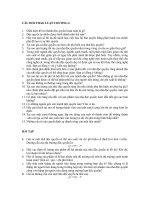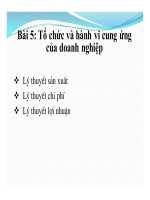KINH TẾ VI MÔ Chapter 5 for student BBA
Bạn đang xem bản rút gọn của tài liệu. Xem và tải ngay bản đầy đủ của tài liệu tại đây (227.75 KB, 23 trang )
CHAPTER 5
THEORY ON FIRM’S BEHAVIOR
Content
*Theory on production
- Production and Production function
- Short run &Long run
- Economies and diseconomies of scale
*Theory on cost
- Total, average and marginal cost
- Economic, Accounting and Sunk cost
*Theory on profit
- Profit
- Total, average and marginal revenue
- Profit maximization and revenue maximization
1
I. Theory on production
1.
Some definitions
- Production
PRODUCTION
INPUTS
OUTPUTS
I. Theory on production
1. Some definitions
-
Short run and long run
+ Short run: is a period of time in which the quantity of at least
one input is fixed (fixed input) and the quantities of the other
inputs can be varied (variable inputs)
+ Long run: is a period of time in which the quantity of all inputs
can be varied
* No specific time that can be marked on the calendar
to separate the short run from the long run
2
I. Theory on production
2. Production function
- The maximum quantity of outputs gained from
certain quantity of inputs at current technology
constraint in a certain time period
Q = f (Xi)
I. Theory on production
2. Production function
-
Cobb-Douglas production function
Q = ALαKβ,
where:
Q = output
L = labour input
K = capital input
α and β = labour and capital's share of output.
3
I. Theory on production
3. Economies and diseconomies of scale
*Increasing returns to scale (Economies of scale):
1% increase in inputs → more than 1% increase in outputs
or f(hX) > hf(X)
*Constant returns to scale:
1% increase in inputs → 1% increase in outputs
or f(hX) = hf(X)
*Decreasing returns to scale (Diseconomies of scale):
1% increase in inputs → less than 1% increase in outputs
or f(hX) < hf(X)
I. Theory on production
3. Economies and diseconomies of scale
In term of Cobb-Douglas production function:
α+β>
1: Increasing returns to scale
α + β = 1: Constant returns to scale:
α + β< 1: Decreasing returns to scale
4
I. Theory on production
3. Economies and
diseconomies of scale
According to Cobb& Douglas:
US economy’s production function
from 1899 - 1912:
Q = L0.25K0.75
⇒ conclusion:
+
+
I. Theory on production
4. Production in short-run
-
Average Product (AP) of an input: equals to total
product divided by the quantity of the input
employed
-
Average Product of labour (APL)
- Average Product of capital (APK)
5
I. Theory on production
4. Production in short-run
-
Marginal Product (MP) of a input is the increase in total
product divided by the increase in the quantity of the input
employed, holding the quantity of all other inputs constant
-
Marginal Product of labour (MPL)
- Marginal Product of capital (MPK)
I. Theory on production
4. Production in short-run
-
The law of diminishing marginal returns: occurs
when the marginal product of an additional input
(e.g. worker) is less than the marginal product of
previous input (i.e. previous worker)
* What is the relationship between MP and AP?
6
Capital
(K)
4
Labour
(L)
0
Output
(Q)
0
4
1
70
4
2
150
4
3
4
4
4
5
4
6
4
7
APL
MPL
75
288
}
52
52
} 10
7
I. Theory on production
5. Production in long-run
Capital
Iso-quantity curve:
(K)
shows the various
combinations of input
quantities that lead to the
same level of output
More quantity
A
C
B
Q2
Q1
Labour
(L)
I. Theory on production
5. Production in long-run
Iso-quantity curve’s characteristics
-
−
-
Downward sloping, the closer to the right hand-side, the more
quantity produced
Never intersect
∆K.MPPK - ∆L . MPPL = 0
→ MPPL / MPPK = ∆K / ∆L
→ MPPL / MPPK : the slope of Iso-quantity curve = The marginal
rate of technical substitution (MRTS)
8
I. Theory on production
5. Production in long-run
MRTS: reduce gradually as
the quantity of input (L)
increase
K
A
B
C
D
L
I. Theory on production
5. Production in long-run
*Special iso-quantity curve
K
Perfect substitute inputs
MRTS = const
vs
L
9
I. Theory on production
5. Production in long-run
*Special iso-quantity curve
K
Perfect Complement inputs
L
I. Theory on production
5. Production in long-run
- Iso-cost: shows the various combinations of inputs that producer
can get from the available cost (i.e amount of money)
TC= r.K + w.L
K
→ K= TC/r – (w/r).L
→ w/r : the slope of total cost
C
Area C: can not afford
A
Area D: Inefficient
B
D
L
10
I. Theory on production
5. Production in long-run
-
Iso-cost:
K
TC, w= const, r changes
r decreases: IC1 → IC2
IC1
r increases: IC1 → IC3
L
I. Theory on production
5. Production in long-run
-
Iso-cost
-
I, r = const, w changes
K
W decreases: IC1 → IC2
W increases: IC1 → IC3
IC1
L
11
I. Theory on production
5. Production in long-run
-
Iso-cost
-
w,r = const, TC changes
K
TC increases: IC1 → IC2
TC decreases: IC1 → IC3
IC1
L
I. Theory on production
6. Production optimzation
K
A
C
D
Q3
B
Q2
Q1
L
12
I. Theory on production
6. Production optimization
At point C, the iso-quantity curve’ slope is equal to the
iso-cost’s slope
Exercise
Firm A has production funtion: Q=100KL,
w=30$, r=120$
a. To produce Q=10.000 units, what is
minimum cost?
b. With available cost TC = 72.000$, what is
maximum quantity that can be produced?
13
II. Theory on cost
1. Cost in short-run
1.1. Fixed cost, variable cost, total cost
-
-
Fixed cost (FC): the cost of a fixed input, independent with
C
the output level
Examples:
Q
II. Theory on cost
1. Cost in short-run
1.1. Fixed cost, variable cost, total cost
-
-
Variable cost (VC): the cost of a variable input, varies with
the output level
C
Examples:
Q
14
II. Theory on cost
1. Cost in short-run
C
1.1. Fixed cost, variable cost,
total cost
- Total cost (TC):is the sum of
total fixed cost and total
variable cost
TC = VC + FC
Q
II. Theory on cost
1. Cost in short-run
C
1.2. Average cost
-
Avarage fixed cost (AFC):
is total fixed cost per unit of
output
AFC =
FC
Q
Q
15
II. Theory on cost
1. Cost in short-run
1.2. Average cost
-
Avarage variable cost
(AVC): is total variable cost
per unit of output
AVC =
-
C
VC
Q
Note: Average curves
(except AFC) is are Ushaped
Q
II. Theory on cost
1. Cost in short-run
1.2. Average cost
- Total average cost (ATC): is
C
total cost per unit of output
ATC =
TC
= AFC + AVC
Q
Q
16
II. Theory on cost
1. Cost in short-run
1.3. Marginal cost (MC): is
the change in total cost
results from a unit
increase in output
MC =
C
∆ TC
= TC ' ( Q )
∆Q
MC intersects AVC and ATC at
their minimum points
Q
II. Theory on cost
2. Cost in long-run
- Long-run total cost (LTC):
C
is the total cost for
production when both
capital and labour can be
varied
Q
17
II. Theory on cost
2. Cost in long-run
- Long-run average total cost (LATC): is long-run
total cost per unit of output
LATC =
LTC
Q
II. Theory on cost
2. Cost in long-run
Increasing returns to scale
Constant returns to scale
Decreasing returns to scale
General
18
II. Theory on cost
2. Cost in long-run
C
Q
II. Theory on cost
2. Cost in long-run
- Long-run marginal cost (LMC): is the change in
long-run total cost results from a unit increase in
output
LMC =
∆LTC
= LTC '(Q )
∆Q
- LMC intersect LTC at its minimum points
19
II. Theory on cost
2. Cost in long-run
Increasing returns to scale
Constant returns to scale
Decreasing returns to scale
General
II. Theory on cost
3. Economic cost, Accounting cost and Sunk cost
-
Economic cost: Total amount paid for inputs used in
production, includes:
-
Explicit cost: Amount paid for inputs that do not belong to the firm’s
owner
-
Implicit cost: Amount paid for inputs that belong to the firm’s owner
Economic Cost
=
Explicit Cost +
Implicit cost
20
II. Theory on cost
3. Economic cost, Accounting cost and Sunk cost
-
Accounting cost: Amount paid for inputs used in
production and reported in accounting notes
Economic Cost
-
=
Accounting Cost +
Opportunity cost
Sunk cost: Amount paid for inputs used in
production which neither be refundable nor
changeable by future decisions/ actions
II. Theory on profit
1. Definition
Profit (Π
Π): is the difference between total revenue and
total cost
Π = TR − TC
Π = Q.P − Q. ATC = Q( P − ATC )
Factos affect on profit:
-
+ P, Q, ATC
+
21
II. Theory on profit
1. Definition
Average revenue: is total revenue per unit of output
AR =
-
TR
Q
Marginal revenue: is the change in total revenue
results from a unit increase in output
MR =
∆ TR
= TR '( Q )
∆Q
II. Theory on profit
2. Profit maximization
ΠMAX ⇔ Π'(Q) = 0
⇔ (TR − TC )'( Q ) = 0
⇔TR'(Q) −TC'(Q) = 0
ΠMAX ⇔MR−MC= 0
ΠMAX ⇔ MR= MC
22
II. Theory on profit
3. Revenue maximization
TRMAX ⇔TR'(Q) = 0
⇔MR= 0
TRMAX ⇔MR= 0
Exercise
Firm A’s demand and total cost functions are as
follows:
P = 12 − 0 .4Q
TC = 0 .6 Q 2 + 4 Q + 5
a.
b.
State out optimal Q,P, Π and TR to prove that
profit maximization and revenue maximization are
quite different
Firm A’s strategy is to earn as much revenue as
possible provided that profit always equal to 10$.
State out optimal Q,P and TR
23









